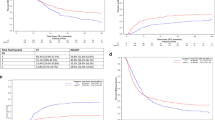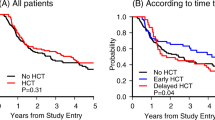Abstract
Non-myeloablative (MA) and reduced intensity allo-SCT regimens are offered to older patients and/or those with comorbidities because the morbidity and mortality attributable to fully MA conditioning is thought to be unacceptably high. A total of 207 patients aged 50–66 years were treated between 1999 and 2008 with SCT after MA conditioning with fludarabine 50 mg/m2 daily × 5 and i.v. BU 3.2 mg/kg daily × 4.90 (43%) had additional TBI 200 cGy × 2. GVHD prophylaxis was CsA, MTX and thymoglobulin (4.5 mg/kg total dose). As defined by the hematopoietic cell transplantation co-morbidity index (HCT-CI) scoring system 117 (57%) pts scored 0 and 90 (43%) ⩾1. At 5 years OS was 39 vs 54% (P=0.008), disease-free survival 38 vs 49% (P=0.03), TRM 39 vs 19% (P=0.003) and relapse 36 vs 39% (P=ns) in those with scores of 0 and ⩾1, respectively. Multivariate analysis confirmed the influence of HCT-CI scores on TRM (subhazard ratios=2.29; 95% confidence interval=1.29–4.08; P=0.005). We conclude that comorbidities as assessed by the HCT-CI do influence TRM with this regimen but that age alone should not be an indication to prefer a less intense protocol.
This is a preview of subscription content, access via your institution
Access options
Subscribe to this journal
Receive 12 print issues and online access
$259.00 per year
only $21.58 per issue
Buy this article
- Purchase on Springer Link
- Instant access to full article PDF
Prices may be subject to local taxes which are calculated during checkout



Similar content being viewed by others
References
Sorror ML, Maris MB, Storb R, Baron F, Sandmaier BM, Maloney DG et al. Hematopoietic cell transplantation (HCT)-specific comorbidity index: a new tool for risk assessment before allogeneic HCT. Blood 2005; 106: 2912–2919.
Sorror ML, Giralt S, Sandmaier BM, Delima M, Shahjahan M, Maloney DG et al. Hematopoietic cell transplantation specific comorbidity index as an outcome predictor for patients with acute myeloid leukemia in first remission: combined FHCRC and MDACC experiences. Blood 2007; 110: 4606–4613.
Sorror ML, Maris MB, Storer B, Sandmaier BM, Diaconescu R, Flowers C et al. Comparing morbidity and mortality of HLA-matched unrelated donor hematopoietic cell transplantation after nonmyeloablative and myeloablative conditioning: influence of pretransplantation comorbidities. Blood 2004; 104: 961–968.
Banna GL, Aversa S, Sileni VC, Favaretto A, Ghiotto C, Monfardini S . Nonmyeloablative allogeneic stem cell transplantation (NST) after truly nonmyeloablative and reduced intensity conditioning regimens. Crit Rev Oncol Hematol 2004; 51: 171–189.
Barrett AJ, Savani BN . Stem cell transplantation with reduced-intensity conditioning regimens: a review of ten years experience with new transplant concepts and new therapeutic agents. Leukemia 2006; 20: 1661–1672.
Aoudjhane M, Labopin M, Gorin NC, Shimoni A, Ruutu T, Kolb HJ et al. Comparative outcome of reduced intensity and myeloablative conditioning regimen in HLA identical sibling allogeneic haematopoietic stem cell transplantation for patients older than 50 years of age with acute myeloblastic leukaemia: a retrospective survey from the acute leukemia working party (ALWP) of the European group for blood and marrow transplantation (EBMT). Leukemia 2005; 19: 2304–2312.
de Lima M, Anagnostopoulos A, Munsell M, Shahjahan M, Ueno N, lppoliti C et al. Nonablative versus reduced-intensity conditioning regimens in the treatment of acute myeloid leukemia and high-risk myelodysplastic syndrome: dose is relevant for long-term disease control after allogeneic hematopoietic stem cell transplantation. Blood 2004; 104: 865–872.
Shimoni A, Hardan I, Shem-Tov N, Yerushalmi R, Avigdor A, Benbassar I et al. Allogeneic hematopoietic stem-cell transplantation in AML and MDS using myeloablative versus reduced-intensity conditioning: the role of dose intensity. Leukemia 2006; 20: 322–328.
Alyea EP, Kim HT, Ho V, Culter C, DeAngelo DJ, Stone R et al. Impact of conditioning regimen intensity on outcome of allogeneic hematopoietic cell transplantation for advanced acute myelogenous leukemia and myelodysplastic syndrome. Biol Blood Marrow Transplant 2006; 12: 1047–1055.
Sorror ML, Sandmaier BM, Storer BE, Maris MB, Baron F, Maloney DG et al. Comorbidity and disease status based risk stratification of outcomes among patients with acute myeloid leukemia or myelodysplasia receiving allogeneic hematopoietic cell transplantation. J Clin Oncol 2007; 25: 4246–4254.
Russell JA, Tran HT, Quinlan D, Chaudbry A, Duggan P, Stewart D et al. Once-daily intravenous busulfan given with fludarabine as conditioning for allogeneic stem cell transplantation: study of pharmacokinetics and early clinical outcomes. Biol Blood Marrow Transplant 2002; 8: 468–476.
de Lima M, Couriel D, Thall PF, Wang X, Madden T, Jones R et al. Once-daily intravenous busulfan and fludarabine: clinical and pharmacokinetic results of a myeloablative, reduced-toxicity conditioning regimen for allogeneic stem cell transplantation in AML and MDS. Blood 2004; 104: 857–864.
Russell JA, Savoie ML, Balogh A, Turner AR, Larratt L, Chaudhry MA et al. Allogeneic transplantation for adult acute leukemia in first and second remission with a novel regimen incorporating daily intravenous busulfan, fludarabine, 400 CGY total-body irradiation, and thymoglobulin. Biol Blood Marrow Transplant 2007; 13: 814–821.
Russell JA, Chaudhry A, Booth K, Brown C, Woodman RC, Valentine K et al. Early outcomes after allogeneic stem cell transplantation for leukemia and myelodysplasia without protective isolation: a 10-year experience. Biol Blood Marrow Transplant 2000; 6: 109–114.
Russell JA, Woodman RC, Poon MC, Jones AR, Ruether BA . Addition of low-dose folinic acid to a methotrexate/cyclosporin A regimen for prevention of acute graft-versus-host disease. Bone Marrow Transplant 1994; 14: 397–401.
Barrett J . Graft-versus-host disease. In: Treleaven J BJ (ed). Bone Marrow Transplantation in Practice. Edinburgh: Churchill Livingstone, 1992: 257.
Chapiro E, Russell L, Lainey E, Kaltenbach S, Della-Valle V, Hanssens K et al. Activating mutation in the TSLPR gene in B-cell precursor lymphoblastic leukemia. Leukemia 2010; 24: 642–645.
Guilfoyle R, Demers A, Bredeson C, Richardson E, Szwajcer D, Sftel MD et al. Performance status, but not the hematopoietic cell transplantation comorbidity index (HCT-CI), predicts mortality at a Canadian transplant center. Bone Marrow Transplant 2009; 43: 133–139.
Labonte L, Iqbal T, Zaidi MA, McDiarmid SA, Hubscb LB, Tay J et al. Utility of comorbidity assessment in predicting transplantation-related toxicity following autologous hematopoietic stem cell transplantation for multiple myeloma. Biol Blood Marrow Transplant 2008; 14: 1039–1044.
Majhail NS, Brunstein CG, McAvoy S, Defor TE, AL-Hazzouri A, Setubal D et al. Does the hematopoietic cell transplantation specific comorbidity index predict transplant outcomes? A validation study in a large cohort of umbilical cord blood and matched related donor transplants. Biol Blood Marrow Transplant 2008; 14: 985–992.
Pollack SM, Steinberg SM, Odom J, Dean RM, Fowler DH, Bishop MR . Assessment of the hematopoietic cell transplantation comorbidity index in non-Hodgkin lymphoma patients receiving reduced-intensity allogeneic hematopoietic stem cell transplantation. Biol Blood Marrow Transplant 2009; 15: 223–230.
Wildes TM, Augustin KM, Sempek D, Zbang QJ, Viji R, Dipersio JF et al. Comorbidities, not age, impact outcomes in autologous stem cell transplant for relapsed non-Hodgkin lymphoma. Biol Blood Marrow Transplant 2008; 14: 840–846.
Farina L, Bruno B, Patriarca F, Spina F, Sorasio R, Morelli M et al. The hematopoietic cell transplantation comorbidity index (HCT-CI) predicts clinical outcomes in lymphoma and myeloma patients after reduced-intensity or non-myeloablative allogeneic stem cell transplantation. Leukemia 2009; 23: 1131–1138.
Sorror ML, Storer B, Storb RF . Validation of the hematopoietic cell transplantation-specific comorbidity index (HCT-CI) in single and multiple institutions: limitations and inferences. Biol Blood Marrow Transplant 2009; 15: 757–758.
Mielcarek M, Storer BE, Sandmaier BM, Sorror ML, Maloney DG, Petersdorf E et al. Comparable outcomes after nonmyeloablative hematopoietic cell transplantation with unrelated and related donors. Biol Blood Marrow Transplant 2007; 13: 1499–1507.
Sorror M, Storer B, Sandmaier BM, Maloney DG, Chauncey TR, Langston A et al. Hematopoietic cell transplantation-comorbidity index and Karnofsky performance status are independent predictors of morbidity and mortality after allogeneic nonmyeloablative hematopoietic cell transplantation. Cancer 2008; 112: 1992–2001.
Sorror ML, Storer BE, Maloney DG, Sandmaier BM, Martin PJ, Storb R . Outcomes after allogeneic hematopoietic cell transplantation with nonmyeloablative or myeloablative conditioning regimens for treatment of lymphoma and chronic lymphocytic leukemia. Blood 2008; 111: 446–452.
Diaconescu R, Flowers CR, Storer B, Sorror ML, Maris MB, Maloney DG et al. Morbidity and mortality with nonmyeloablative compared with myeloablative conditioning before hematopoietic cell transplantation from HLA-matched related donors. Blood 2004; 104: 1550–1558.
Barba P, Pinana JL, Martino R, Valcarcel D, Amoros A, Sureda A et al. Comparison of two pretransplant predictive models and a flexible HCT-CI using different cut off points to determine low-, intermediate-, and high-risk groups: the flexible HCT-CI Is the best predictor of TRM and OS in a population of patients undergoing allo-RIC. Biol Blood Marrow Transplant 2010; 16: 413–420.
Ringden O, Labopin M, Ehninger G, Neiderwieser D, Olsson R, Basara N et al. Reduced intensity conditioning compared with myeloablative conditioning using unrelated donor transplants in patients with acute myeloid leukemia. J Clin Oncol 2009; 27: 4570–4577.
Russell JA, Irish W, Balogh A, Chaudry MA, Savoie ML, Turner AR et al. The addition of 400 cGY total body irradiation to a regimen incorporating once-daily intravenous busulfan, fludarabine, and antithymocyte globulin reduces relapse without affecting nonrelapse mortality in acute myelogenous leukemia. Biol Blood Marrow Transplant 2010; 16: 509–514.
Kasbia G, Al-Gahtani F, Tay J, Labonate L, Tinmouth A, Gillingham A et al. Reduced hemoglobin on day of peripheral blood progenitor cell collection is associated with low graft content of vascular progenitors and increased toxicity after autologous hematopoietic stem cell transplantation. Transfusion 2008; 48: 2421–2428.
Alatrash G, Andersson B, Pelosini M, Rondon G, Qazilbash S, Giralt S et al. Allogeneic hematopoietic stem cell transplant (HSCT) for patients in the 6th and 7th decades of life with AML or MDS using myeloablative, reduced toxicity IV busulfan/fludarabine (BuFlu) conditioning regimen Abstract, American Society for Blood and Marrow Transplantation 2009 BMT Tandem Meeting, 11–15 February 2009, Tampa, FL.
Acknowledgements
We thank the nursing staff at foothills hospital, Tom Baker cancer centre, Cross cancer institute for their care of these patients.
Author information
Authors and Affiliations
Corresponding author
Ethics declarations
Competing interests
The authors declare no conflict of interest.
Rights and permissions
About this article
Cite this article
El Kourashy, S., Williamson, T., Chaudhry, M. et al. Influence of comorbidities on transplant outcomes in patients aged 50 years or more after myeloablative conditioning incorporating fludarabine, BU and ATG. Bone Marrow Transplant 46, 1077–1083 (2011). https://doi.org/10.1038/bmt.2010.257
Received:
Revised:
Accepted:
Published:
Issue Date:
DOI: https://doi.org/10.1038/bmt.2010.257
Keywords
This article is cited by
-
Myeloablative intravenous busulfan-containing regimens for allo-HSCT in AML or MDS patients over 54 years old: combined results of three phase II studies
International Journal of Hematology (2020)
-
I.v. BU/fludarabine plus melphalan or TBI in unrelated cord blood transplantation for high-risk hematological diseases
Bone Marrow Transplantation (2015)
-
Reduced-intensity allografting in patients with therapy-related myeloid neoplasms and active primary malignancies
Bone Marrow Transplantation (2011)



